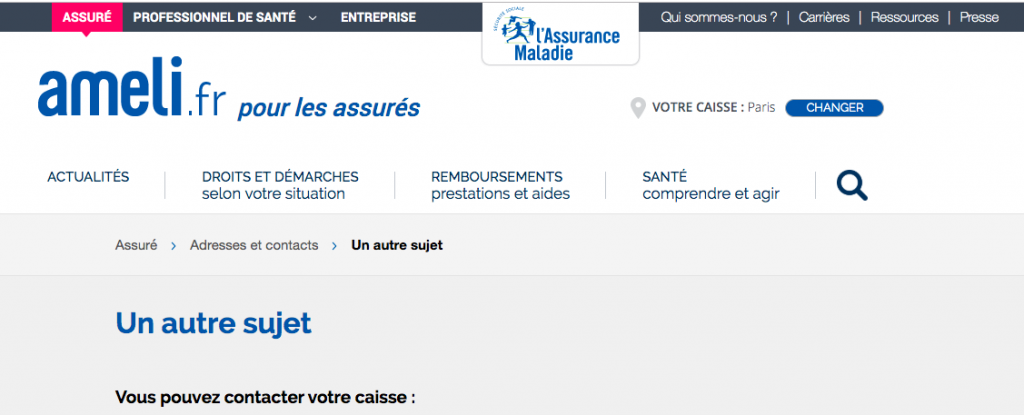This month I celebrate my two years in France (2.5 if I count my 6-month stay in 2015 ;)) and I guess I can finally say that I conquered all bureaucratic challenges that this country has thrown at me. I have an apartment, a job, I pay taxes, I’m able to vote for certain elections (and my home country knows where to find me in case of elections there) and, the one that caused the most headache, I have French health insurance.
Probably if you’re reading this, you’re about to apply for your own social security number and Carte Vitale. Yes, the gift of French health insurance! I will try to describe my 8-month journey to get one as detailed as possible.
Yes, you read this right, it took me 8 months to get my Carte Vitale. You might read on different websites that this will take you only two months and that your temporary number will allow you to already benefit from the (good!) health system, but I can confirm that it’s rare that in two months from now you will be looking at your new green piece of plastic.
When am I eligible for French health insurance?
You’re eligible to get a numéro sécu (social security number) if you work in France or if you have been living in France since more than three months in a stable situation. You can only get a Carte Vitale if you have a French social security number /French health insurance.
Personally I already had a job (temporary CDD) when applying for a numéro sécu, your situation might be slightly different from mine but I take it my experience might still come in useful :).
Note for Dutch readers: if you don’t work and live in the Netherlands you cannot keep your Dutch health insurance. But don’t cut it immediately! You never know if you break your arm tomorrow and in that case you won’t be insured. You have the right to have Dutch insurance for the first 8 months of your stay abroad, as long as you did not as long as you are not deregistered with your municipality.
Where to start?
It all starts with this form. This form is your request for a social security number. The information is quite basic, at A you add your personal information (name, address, …). Note that you can leave certain field open, such as your numéro sécu (duh), numéro allocataire and CAF. Personally I have benefited from CAF in the past but I had no clue what my number was, so even if you have any of these numbers but you don’t know them, leave the fields open.
At B you include information about your work. Activité professionnelle is where you write down your job title. If you’re unemployed you can say so at Sans activité. If you do so, you have to state your arrival date in France.
At C you acknowledge that everything you have written down is true information. An Attenstation sur l’honneur basically means under oath.
Which documents do I need?
You should print the form and add the following documents:
- 1. If you’re from the European Union: A copy of your passport or identity card;
- 2. If you’re from outside the European Union: A copy of your residence permit;
- 3. A copy of your birth certificate in French (for the Dutch readers among you: you can easily ask for one at the city you’ve been born, you can ask for a multilingual one);
- 4. Your RIB, relevé d’identité bancaire, this should be of a French bank and you can easily download it if you log in online to your French bank account;
- 5. If you’re unemployed: any document that proves that you are financially stable;
- 6.If you’re employed: your contract and the three last salary slips: I didn’t have any ‘official’ pay slips yet at the time I applied, so I added my unofficial pay slips as an intern (there was no tax information on it whatsoever), they accepted this so I take it that it’s not mandatory to add your pay slips if you don’t have any yet.
Where to send it to?
You have to send everything to the CPAM, the Caisse Primaire d’Assurance Maladie. This office is your first contact point for all your insurance questions. Every city has it’s own Caisse. If you’re in Paris, the address is
Assurance Maladie de Paris
75948 PARIS CEDEX 19
If you don’t know which Caisse you belong to, you can go to this website and click on “Changer” (right top) to change your Caisse. There you add your postal code and you will be lead to your Caisse automatically. To find the address, scroll down to “Par Courrier” (by post) and the address will be displayed.

Personally, I have a CPAM office close to my work so I went there, had my documents checked quickly and put everything in their local mailbox. Now I just had to wait.
What happened next will shock you
Just kidding, from here on, everything should be easy and quite fast, but I know very little stories where this was actually the case. With my Dutch friends (we all arrived in France around the same time), we had a private joke about the incapable intern Jean-Baptiste that was taking care of all Dutch applications and obviously, he wasn’t very skilled.
My first letter came after about one month, stating that I had to send my RIB, even though I was certain that I already sent it to them (and I got it checked by someone at the CPAM before sending it). One month later I received a new letter stating that I had forgotten to send a copy of my passport. In my opinion this, too, was impossible, but what was I going to do about it?
In the meantime, I never received my temporary number. By the time I finally received my numéro sécu (3-5 months later), I was quite confused. Usually, from the moment you receive a temporary number and from then you have the right to get refunded all your medical expenses once you have your Carte Vitale. I later learned that I had the right from the date on my application.
I’ve finally got my social security number, what’s next?
Well, bravo! Next thing to do is to go celebrate, before you jump into French bureaucracy again 😉
The next step is certainly the step that caused me most stress. You will have to create an account on Ameli.fr, the online portal for your health insurance. Fill in all information and they will send you an activation code by post. This code will be valid for 2 weeks, and my problem was that I sometimes only received it after 15 days (and I live in Paris). I guess it won’t be this difficult for you, maybe it was just my gardien. I also made the mistake to recreate an account (and so ask for a new activation code), instead of logging in here. So: once you have your activation code, click on ‘me connecter‘, instead of saying you don’t have an account yet. Anyway, I had to do 3 attempts or 2 weeks before I actually was able to activate my account.
I have my Ameli.fr account!
By the time I had my account I received my letter stating that I could get a Carte Vitale if I send them a picture to put on it. Having had a bad experience with sending my documents to the CPAM, I decided to upload it online in my Ameli account, which was quite easy.
A few weeks later I finally had my Carte Vitale. And I can say that, even though it caused me a lot of stress, it was definitely worth the wait. France has an incredible health system and you only have to show your Carte Vitale when going to the doctor, and often you don’t pay anything.
Good luck with yours and don’t hesitate to comment if you have questions or if you have something to add 🙂
And finally, here’s a list of some useful links
- This official (French) explanation on what a numéro sécu is and how to obtain one;
- To application form to request for a social security number;
- This website to find out what your CPAM is, and how to contact it;
- Ameli.fr, the online portal.
